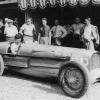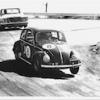Aircraft-engined cars
#1

Posted 16 December 2003 - 17:25
http://www.americanj...ml/pioneer1.htm
http://www.americanj...os/arfbro13.htm
The performance of these cars shows not only that the forward seating position of the Mercedes-Benz T-80 may not have a handicapp whatsoever, but how it was possible to build a car powered by a big aircraft V-12 much lighter than the T-80.
Advertisement
#2

Posted 16 December 2003 - 23:55
Originally posted by Franklin
http://www.ugofadini.../omicron02.html
http://www.americanj...ml/pioneer1.htm
http://www.americanj...os/arfbro13.htm
The performance of these cars shows not only that the forward seating position of the Mercedes-Benz T-80 may not have a handicapp whatsoever, but how it was possible to build a car powered by a big aircraft V-12 much lighter than the T-80.
Is it possible? Yes, I think so, as compared to a turbo-jet or turbo-fan aircraft engine capable of propelling a car to LSR potential, you are talking about a military jet engine at least as large as a GE J47, or larger, and those engines are both large and heavy (have no real idea as to the weight of one, though).
However, both of Ab Jenkins' "Mormon Meteor" record cars of the 1937-41 used the pre-WW-II Curtiss Conqueror V12 Aero engines, which were rated at about 700hp, if memory serves me correctly.
The first Mormon Meteor, built as a highly hopped up Duesenberg Model J, on the 142.5" wheelbase chassis, was actually termed the "Duesenberg Special", with a street-stock Model J chassis, carrying special racing bodywork. The engine was modified to the extent of having a 2-stage centrifugal supercharger, dual updraft carburetors (the carbs were the same basic units used singly on SJ Duesenbergs, with carefully crafted "rams horn" intake manifolds from blower to intake ports. This engine ostensibly dyno'd at 425hp, quite an automobile powerplant for those days (essentially the same engine setup was installed in the short (125") wheelbase, so-called SSJ Duesenbergs which were originally owned by Clark Gable and Gary Cooper, both of Hollywood fame). Upon completion of the 24-hour record runs at Bonneville, achieved just as Auburn Automobile Company (parent of Duesenberg Inc.) was shutting the doors forever in the late summer of 1937, Ab Jenkins bought the car from Duesenberg at a pre-arranged price of $5000 (what a steal that was!). Over the winter of 1937, Jenkins, with the aid of August "Augie" Duesenberg, modified the chassis to accept the Curtiss Conqueror V12, which was the same engine used in the then-still-operational Curtiss P-6E Hawk US Army biplane fighter, as well as the Curtiss Condor airliner. After further 24 hour attempts in 1938 (also at Bonneville), Jenkins retired this car from active LSR use, returning it to its stock Duesenberg configuration, modifying the bodywork to make it a streetable car, in which form it still exists today (this car led the "Parade of Classics" at Auburn Indiana's "Auburn-Cord-Duesenberg Reunion", a role this car has fulfilled several times over the years of this event.
In the winter of 1938-39, Jenkins and Augie Duesenberg built an all new 24hr LSR car, this time termed "Mormon Meteor III", using a highly modified Duesenberg Model J chassis design, but this time with provision for either one, or two Conqueror V12's (although the second engine was never installed). This car used a heavy-duty truck transmission, to better handle the immense torque of the V12, which was fairly lightweight as aero V12's go, seeing as it powered a very small fighter plane, and the Curtiss Condor was not particularly a large airliner either. This car was dubbed "Mormon Meteor III" (the original Duesenberg Special became known to this day as Mormon Meteor I with the Duesenberg engine, and Mormon Meteor II with the V12--Mormon Meteor being also Ab Jenkins' racing nickname). Mormon Meteor III made 24 hour runs in 1940 and 1941, was retired to the Utah Statehouse in Salt Lake City, with the proviso that Jenkins could pull it out, and run it again at pretty much anytime he so chose (which he did in the late 1940's).
About 1996, during renovations of the Statehouse at Salt Lake City, Mormon Meteor III was removed from its glass case in the lower level of the building, and stored outside. Marvin Jenkins. Ab's son, found the car seriously deteriorating, due to rains, and the fact that, like all salt flats cars, it carried considerable salt residues which destroyed the magnesium portions of the aircraft engine, and had ruined the transmission, and were working on the aluminum bodywork. He laid claim to the car, under a provision of his father's deed of gift, that the car be preserved (which it was not!), and after a short legal battle, regained posession of the car, which he had not only helped build, but had also driven more miles at speed than his famous father, being his father's chief mechanic in the late 1930's. The car is now fully restored, and is runnable. I saw the car in September 1997, and spent over an hour with it, as Marvin Jenkins explained its inner workings to me, at Auburn Indiana, where it was displayed for the annual ACD get-together. A neat, neat car, and according to Jenkins, it weighs about 4000 lbs dry.
Marvin Jenkins was also one of the mechanical team involved in the Winfield V8 project in 1941 and 1948, otherwise known as the Novi.
Art Anderson
#3

Posted 17 December 2003 - 02:13
http://forums.atlasf...&threadid=44519
(The Mercedes-Benz T-80)
#4

Posted 17 December 2003 - 11:08
#5

Posted 18 December 2003 - 10:15
Many thanks, Art, for your update on the status of MM III. Gordon White has been filling me in on the car and sent a few photos of the chassis, which helped. I would say that the chassis is entirely unique and not at all indebted to the big Duesey.
I still haven't figured out where they planned to put the second engine.
IMHO MM III is the most important car in the world that has never been properly described and documented.
#6

Posted 18 December 2003 - 15:40
#7

Posted 18 December 2003 - 16:22
In 1947 John Cobb ran a best one-way speed of 403 mph.
In 1960 Mickey Thompson ran a best one-way speed of 406 mph.
In 1965 Bob Summers ran a best one-way speed of 425 mph. (Summers remains the FIA record holder for normally aspirated cars.)
In 1991 Al Teague ran a best one-way speed of 425 mph. (Teague remains the FIA record holder for supercharged cars.)
In 2000 Tom Burkland ran a best one-way speed of 438 mph.
When Burkland made his run, Bonneville was as dry as it gets but he could not use more than 60% of the throttle travel before encountering severe wheelspin.
#8

Posted 18 December 2003 - 16:54
Originally posted by Franklin
In 2000 Tom Burkland ran a best one-way speed of 438 mph.
When Burkland made his run, Bonneville was as dry as it gets but he could not use more than 60% of the throttle travel before encountering severe wheelspin.
Wheelspin at 438mph!!! Now that's something
#9

Posted 19 December 2003 - 01:04
Isn't the web a wondrous place? Here I just happen to find two people I admire a great deal, sharing info on the same topic! At the Denver CART event this year I was wandering through the concession area and what should I find but the MMIII on display, with Marv Jenkins on hand. We spent several hours as he showed me around the car and described all its unique features and told stories. While in his 80's Marv has an astonishing memory, and knows this car absolutely intimately as he spent his summers with Augie Duesenberg in Indianapolis as a youth and participated in the construction. Later on he drove the MMIII untold miles as Firestone used it as a tire testing mule. I'm glad he was able to retreive the car. As Art relates, Marv is a walking library of racing lore, as he worked not only with his dad and Augie Duesenberg but with Lew Welch and the entire Novi circle.
I have to agree the MMIII shares almost nothing with any Duesenberg. The two Model J frame rails are about it, with considerable bridge trussing added underneath -- partly to serve as riders should a tire blow at speed on the salt. Also, for a one-off special you can see some elaborate patternworking etc. went into its construction. It's not every day one sees a Curtiss Conqueror engine either, in or out of an airplane. But getting back to my great conversation with Marv Jenkins...eventually I had to leave. Apparently there was a CART race or something going on that day which required covering -Bill McGuire
#10

Posted 20 December 2003 - 01:02
Originally posted by karlcars
This thread is of great interest to me as I'm working on a book about cars with V12 engines, and the Curtiss-powered Meteors certainly qualify.
Many thanks, Art, for your update on the status of MM III. Gordon White has been filling me in on the car and sent a few photos of the chassis, which helped. I would say that the chassis is entirely unique and not at all indebted to the big Duesey.
I still haven't figured out where they planned to put the second engine.
IMHO MM III is the most important car in the world that has never been properly described and documented.
Karl,
Well, yes in a way, Mormon Meteor III is indebted to the "big Duesy", simply because of the use of Duesenberg Model J frame rails. Consider for example, the sheer size of MM-III: It's as big as a Duesenberg Model J for starters. Secondly, there probably weren't any other ready-made frame rails around, outside of heavy-duty truck frames that could have held the weight and torque of the Conqueror engine.
However, a Model J Duesenberg (all of them, by the way) frame relied on aluminum castings for crossmembers, or at least the connecting members joining crossmembers to the side rails, which alone made the Duesenberg Spl/Mormon Meteor I (with the 420cid supercharged straight 8) and Mormon Meteor II (same chassis and body with the Conqueror engine) inadequate to handle the much larger, more potent aero V12 engine. Marvin Jenkins alludes to this in the book "Salt of the Earth", the story of his father's speed conquests at Bonneville in the 1920's through his death in 1956.
I do also seem to recall, upon studying the Mormon Meteor III when it was at Auburn IN in 1997, that it had a Model J Duesenberg front axle, and I believe also the Model J Duesenberg rear axle (talk about "overbuilt" eh?).
I believe that Marvin Jenkins told me that the idea was to install the second engine behind the cockpit, backwards, and connect it to the transmission via a transfer case, which would probably have been a bit of a mechanical nightmare, but not at all impossible to do.
Art Anderson
#11

Posted 20 December 2003 - 10:58
The chassis photos of MMIII provided to me by Gordon White show little resemblance to a Duesey. For example, the front hubs have hollow centers to provide for the later use of four-wheel-drive if required. As well, MMIII had a de Dion rear axle with universal-jointed half-shafts. This was adopted after MMII proved to be virtually unmanageable when Curtiss-powered when its fuel tanks were low, thanks to the high unsprung weight of the Duesey rear axle.
See why I say there has to be a really good study -- with cutaway drawings -- of this great record-breaker? Over to you, Gordon White!
#12

Posted 20 December 2003 - 13:42
#13

Posted 20 December 2003 - 13:55
#14

Posted 21 December 2003 - 21:11
Originally posted by McGuire
In case there is any confusion: Mormon Meteor I and Mormon Meteor II are of course the same car, built on the same 142.5" wb Duesenberg chassis. Except for its racing bodywork designed by Herb Newport and the engine modifications detailed by Mr. Anderson, Meteor I was essentially a production Duesenberg. In its original form this car was also known as the Duesenberg Special. When the supercharged straight 8 was removed and a Curtiss V-1570 Conqueror aircraft engine was installed, Meteor I became Meteor II. As this car was later returned to its Mormon Meteor I configuration, the "Mormon Meteor II" no longer exists. The Meteor I aka Duesenberg Special is now owned by collector Knox Kershaw of Montgomery, AL and is frequently seen at Auburn, Pebble Beach, Goodwood, and elsewhere.
And, of all the Model J Duesenbergs extant today, except for one Murphy-bodied roadster, the various J's built for George Whittel of Lake Tahoe & Woodland California, the Duesenberg Special is perhaps the most traceable of all Duesenbergs, having been through just 2 owners after its record runs. Knox Kershaw's father bought the car from a Chicago Duesenberg "dealer" in the late 1940's, and as you note, the car remains in the Kershaw family to this day. The special intake manifolding, dubbed the "ram's horn" system (two separate cold air pipes, each with a beautifully curved split pipe at the outer end, connecting to the intake ports of the head, where a standard J or SJ used a 4-branch cast aluminum intake), was connected to a specially built Schwitzer 2-stage centrifugal supercharger, that equipped with two Duesenberg Zenith updraft carburetors. This supercharger setup, along with the internal engine modifications, was duplicated twice in 1935, for the pair of SSJ 125" wb roadsters built for Hollywood friends and rivals, Gary Cooper and Clark Gable. Both of these cars exist still, restored but unmodified.
According to JL Elbert, author of the first comprehensive book on the Duesenberg, "Duesenberg, The Mightiest American Motorcar", first published in 1951, the Duesenberg Special was of course, built in the Duesenberg Inc. factory on West Washington Street in Indianapolis (that building was later sold and was used as a maintenance garage for the municipal city bus company in Indianapolis until its demolition about 12-13 years ago to make way for the White River State Park and Indianapolis Zoo).
However, Elbert writes, and I deduce that he interviewed August Duesenberg, who by the late 1940's was living in retirement on a small farm near Indianapolis, that Mormon Meteor III was built, not in the Duesenberg, Inc. factory building, but rather in Augie Duesenberg's shop, which was across Washington Street to the south, from the Duesenberg Inc. plant, that structure having been closed and sold off in early 1937.
For some excellent viewing, I highly recommend the video-transcribed Auburn Automobile Company's promotional film of the 1935 24 hour record run at Bonneville. About ten years ago, while renovating the long-closed movie theater in downtown Auburn, IN, the theater owner discovered, in the projection booth, a nearly mint copy of this film, which was professionally shot and produced for Auburn Automobile. It's in sound, and almost totally free of any scratches or flickers, making it a fabulous look at a fabulous car, at speed. Included in the footage are many very good resolution shots of the car, both standing still, and at very slow speeds, including a full panned shot of the belly pan, with its hundreds of louvers. This film (and the name escapes me at the moment--it's packed away from my recent move to my present home) is still available from the gift shop of the Auburn Cord Duesenberg Museum in Auburn Indiana, for about $25 or so.
Part of this film is coverage also of the 1935 endurance record run by Ab Jenkins in the fabulous Auburn 851 Speedster, the sound of this car and the Special at speed is simply astonishing to listen to.
Art Anderson
#15

Posted 22 December 2003 - 01:50
Not an LSR car, but the Chitty Chitty Ban Bang cars built by Count Zborowski chassis Mercedes chassis mated with an aero engine - a Maybach (23l - 6 cylinder) for the first, and a Benz (18.8l) for the second. These were for racing at Brooklands, which the first did quite successfully.
Zborowski and the Chitty Chitty Bang Bangs
Zborowski also built the car that would later become known as "Babs". It was powered by a V12 Liberty aero engine.
A guy in Australia has recently built a '55 Chevy fitted with a Packard Merlin engine. It is road registered, but it is really a show car.
I think the all up weight of that is about 3000kg.
#16

Posted 22 December 2003 - 18:34
First, its winning time was 20 minutes and 56 seconds, which is not all that shabby even by modern standards.
Next, its driver was a young man named Rea Lentz, who was reportedly 16 years old at the time. He apparently took his $2000 in winnings and promptly retired, after beating Rickenbacker, Oldfield, and the other stars in attendance.
Third, the vehicle, which contemporary reports describe as the smallest and lightest car in the event. The only two photos I have (poor) seem to show a car of roughly small Marion or Overland size, probably production-based, with parallel semi-elliptic springs up front, frame rails probably only 4-5" or so deep, a cut down racing body with no fenders, bullnose radiator shell, a rather wide track, and unusally oversized (especially for the era) wood-spoke wheels. Looks to me like they knew what they were doing for the time: light car, large engine, big wheels and tires. This car was also variously described as powered by a Curtiss V8 aircraft engine of 420 CID, 420 HP, 402 CID, and 125 HP, etc. depending upon sources. Rather confusing.
I think we can safely rule out 420 HP, as in 1916 an aero engine of that output would be nearly the size of a yard locomotive. If the engine is indeed a Curtiss it would presumably be of the OX series, but they were typically 503 CID and 90 HP in stock form. But the OX would be a fit for this vehicle, since it weighed only 380 lbs.
Can any of the experts here shed some light on this car?
#17

Posted 26 December 2003 - 23:38
great New Zealand built car in 1956 it looked like a Lotus 7 on steriods.Road reg it was driven to and from the tracks across NZ. And the highlight of it,s career was in 1960 Lady Wigram
trophy race in Christchurch .Bruce McLaren blew up his car in pratice and was offered the special
and he went on to finish 4th four minutes behind Jack Brabham in a 2.5 Cooper.
It was built by Ralph Watson and used a 5.3 liter flat 4 aircraft motor power figures around130hp at 2200rpm with huge amount of torque ,the motor was mounted upside down and back to front to it,s normal aircraft position , it was drysumped and it drive was through a Studebaker gearbox
fitted with Chrysler gears through a tailshaft to a modified Fordv8 final drive . A modified Vauxhall Velox front suspenion along with Austin A40&A50 parts an steering through a Morris Minor rack
de Dion rear suspenion and Hillman drum drakes that went off very very quickly as Bruce found out
after only a few laps all this running gear was mounted in a tube ladder frame on 15 inch wheels
and covered in an Alloy body. In 1994 it came over from NZ to race in the HSRCA Eastern Creek meeting by it,s then owner Ralph Smith, still looking great in it,s polished alloy body with RED nose strips and it was still road rego and sounded just great . It now had Dunlop disc fitted to slow the beast down a top speed of 150mph they where fitted just after it,s day of Glory when it took one of NZ famous sons around much to the delight of all kiwi,s in attendance.
______________________________________________________
I do hope some one can supply a photo of the LYCOMING SPECAIL.
#18

Posted 27 December 2003 - 01:48
Although the Sabakat fits the bill, it clearly wasn't Neville Shute's inspiration. Even allowing for the inventiveness of authors (my apologies to real authors, I really mean novelists), something must have inspired Shute's description.
Any ideas?
#19

Posted 27 December 2003 - 02:47
AAA Tacoma, WA July 4, 1915 - 2-mile board track, 250 miles - started 24th, finished 10th
AAA Sheepshead Bay, NY October 28, 1916 2-mile board track, 100 miles, start 27th, finish 21st
Santa Monica CA Nov. 16, 1916 300 miles Rea Lentz driver, "Hartman Special" did not appear
To me this casts serious doubt on the story that Lentz was 16 in 1916, if he was running AAA board tracks in 1915. Would this have been possible in the AAA at that time?
I also found some references to Rea Lentz driving for the factory Velie team throughout the west in 1915, and the suggestion that Tacoma WA was his home town.
Advertisement
#20

Posted 27 July 2012 - 08:56

The car was built by Arthur Delisle of Massachussetts. The lack of a radiator lead to the rather unusual bonnet profile.
One of the drawbacks of the engine was that the carburettor was located on the bottom of the engine, leading to problems
with dirt being ingested into the engine.
Source: http://www.racingthr...R10/3-10-10.htm
#21

Posted 27 July 2012 - 09:14
http://www.autofiend...rlin-v12-beast/
http://www.spainvia.com/merlincar.htm
#22

Posted 27 July 2012 - 09:25
#23

Posted 27 July 2012 - 09:38
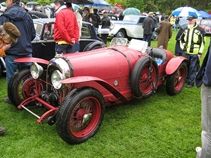
A beautifully rendered device.
"Babs", of course, also being an aero-engined land speed record car.
Edited by Hamish Robson, 27 July 2012 - 10:24.
#24

Posted 27 July 2012 - 10:07
There was Stuart Saunders' MAB, Tony Osborne's Delage, and Des Dillon[?]'s special. From memory they were all 12 cylinder Liberty engines. Marvelous!
#25

Posted 27 July 2012 - 10:51
Rod Hadfield, well known Aussie Hotrodder had a 57 Chev a few years back with a Merlin in it. A bit underwhelming when he started it.Does anyone remember John Dodds Merlin engined road car. I saw it doing a demo at Silverstone in the 70's. Apparently it still exists (in Spain) and is still registered for the road.
http://www.autofiend...rlin-v12-beast/
http://www.spainvia.com/merlincar.htm
Jay Leno has a hotrod that is Merlin powered, currently it seems to be having an overhaul.
In the very distant past there was a Merlin powered FJ Holden used in drag racing,, very agricultural.
Stretching things a little but no end of speedway F500 cars were Rotax and Polaris powered in the past. While primarily snowmobile engines they are also used in ultralight aircraft in a different spec.
#26

Posted 27 July 2012 - 11:02
______________________________________________________
I do hope some one can supply a photo of the LYCOMING SPECAIL.
Your wish is my command.

This is the only photo I have readily available, of Jim Boyd driving the Lycoming at a (gravel) hillclimb in October 1965 at Chamberlain Road, Bombay NZ. Earlier that year, Boyd won the Dunedin round of the NZ Gold Star (formule libre) championship in the car, when several of the main contenders fell over each other. The car was around for such a long period, it was almost part of the wallpaper. I can think of at least 2 more aero-engined cars raced in NZ in the 1950's and 1960's too.
Stu
#27

Posted 27 July 2012 - 11:06
I think that the engine is actually a Meteor rather than a Merlin. Some of the text suggests this is the case.Does anyone remember John Dodds Merlin engined road car. I saw it doing a demo at Silverstone in the 70's. Apparently it still exists (in Spain) and is still registered for the road.
http://www.autofiend...rlin-v12-beast/
http://www.spainvia.com/merlincar.htm
The Meteor is a derivative of the Merlin for use in tanks and things and is unsupercharged. I suspect it has a different, less 'peaky' cam profile making it more tractable for road use rather than the essentially single speed Merlin aircraft engine. Some restored WW2 aircraft, restored to "taxiable condition" rather than to full "flying condition" have used a Meteor engine.
Obviously it is more glamorous to say it is Merlin engined rather than dilute it to "Merlin-based engine" which is almost true. Some of the in-period claims for the car were ludicrously exaggerated, eg a sub-9 minute lap of the Nurburgring. But it gave a lot of harmless fun and enjoyment to the creator and a lot of people.
#28

Posted 27 July 2012 - 11:20
#29

Posted 27 July 2012 - 12:33
youtube video link
#30

Posted 27 July 2012 - 19:19
Me: "Was it your car then?"
Dave: "No, it belonged to a couple of fellows up in Duncan. I didn't
drive it very long. I won a couple of races with it, it was a very
powerful thing."
Me: "So the Ranger engine was out of an aircraft then?"
Dave: "Yeah, World War II aircraft and they turned it around. In the
aircraft, it ran with the valves down, you know. It was different,
I'll tell you that. I didn't have anything to do with the mechanical
end of it."
Dave said it was a six-cylinder, a high engine. There were other
ones from Seattle, including Del Fanning. Dave's had a home-made
chassis. He has a picture of it, but his son has his pictures in
Vancouver.
Vince H.
#31

Posted 29 July 2012 - 03:56
He died last decade, but I talked to him about once and he said he ran it till the early sixties when they were pretty much killed by rule changes.
#32

Posted 29 July 2012 - 15:19
As for the Romano, most secondary sources state that it had a Curtiss engine, but I believe those are mistaken. The only contemporary source (1913) mentioning the make of engine calls it a Hall-Scott, with the specs 402 CID and 125 HP. Somewhere, I'd seen a (poor) newspaper picture, but I can't find it now - all I recall was a very wide V-angle (90° or more) and overhead valves. Someone with more knowledge about early aircraft engines may be able to make a run out of that. It is remotely possible that the car was later fitted with a Curtiss, but the fact that it was basically designed and tailor-fit around the original engine makes it rather unlikely.
The original Romano Special (there were other cars by that name later on) was built by E. J. "Gene" or "Jean" Romano of Seattle in 1913, it seems. Percy Barnes drove the car mostly during the first two seasons, but also Jimmy Parsons, Joe Thomas and Charles Latta, taking many wins throughout the Northwest. Lentz became the regular driver in 1915, and stayed with the team until 1919, by which time Romano ran up to three cars, making it difficult to determine which was which. Other team drivers during the time included Tip Blume, Henry North, Gus Duray, Jimmy Buttera, Latta again and Romano himself. By 1921, Mario Bianchi had become the team's leading driver, and he crashed the Romano at Vancouver (BC) in June of that year - perhaps the end for the car.
EDIT: a little bit of digging found further specs from 1913: total weight 2700 lbs (not THAT light, anyway!), engine now rated at 75 HP and dimensions given as 5" * 4", still with 402 CID which doesn't make sense - even at 4" * 5" it would amount to 502.7 CID. Not sure what to make of that.
Edited by Michael Ferner, 29 July 2012 - 16:00.
#33

Posted 29 July 2012 - 16:41
#34

Posted 29 July 2012 - 17:03
Some famous cars with Ranger engines were run by "Dizz" Wilson out of Indiana and O. R. Hukle out of Florida, both running multi car teams, Bert Hellmueller, Mark Bowles, George Libbey, Manuel Canal, Pittman & Earle, Leon Hubble, Speedy Helm, Manuel Fernandez, Foggy Callaway, Red Lempelius, Gregg Tiederman, Ken Stansberry, Marvin Faw, Whitey Osell and Hank Hanestad, the latter running his car as late as 1972 in NARC competition in California. Sid Bufkin won both the 1951 and '52 CSRA Championship in a Wilson/Ranger.
As for aero-engined Sprint Cars, the most famous were, of course, the many "Hisso" conversions of Hispano-Suiza V8 engines "cut in half" to make for 359 CID 4-cylinder engines, eligible for AAA during most of the thirties.
#35

Posted 29 July 2012 - 17:39
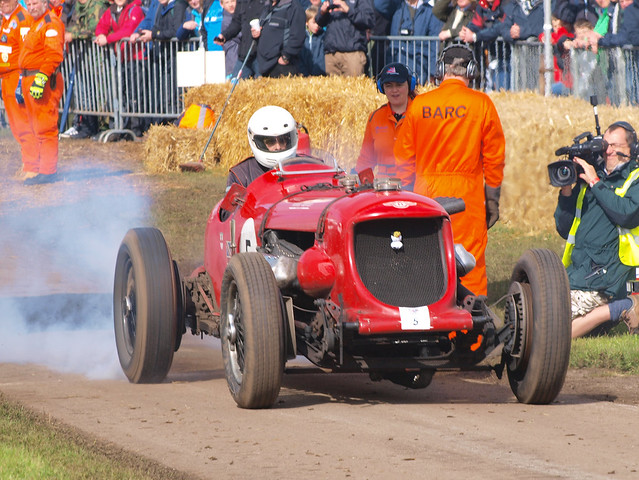
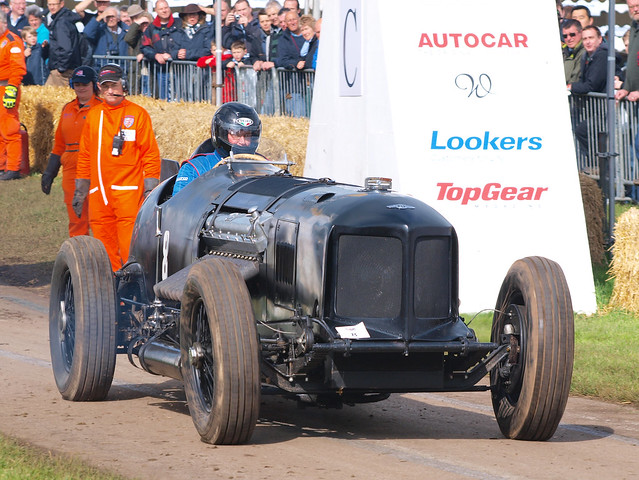
#36

Posted 29 July 2012 - 17:40
No, but the Napier-Bentley has (two posts before)Has Chris Williams been mentioned yet?
#37

Posted 29 July 2012 - 17:58
No, but the Napier-Bentley has (two posts before)
Which prompted my post
I was also at the last Crystal Palace meeting but have also seen this car for years. How many owners has it had?
#38

Posted 29 July 2012 - 21:08
#39

Posted 29 July 2012 - 22:46
My recollection is much the same.Memory's a bit hazy here, but I think David Llewellyn and Peter Morley might have initially shared ownership, though Morley was sole owner/driver for many years thereafter. I also think Chris Williams has been the only other owner (or have I forgotten someone between Morley and Williams?)
David built it using the same engine that had been used in the Sunbeam known as Tigresse for a while, but Chris is now so firmly associated with it that I've even seen him listed as its builder!
Advertisement
#40

Posted 30 July 2012 - 22:04
I see that Rea Lentz and the Romano Special have been mentioned earlier in this thread, and I believe I can shed some light. There are apparently a few myths in circulation, such as Lentz's age - he was certainly much older than 16 when he won the Pikes Peak climb, though I don't have a better answer than that. But he was competing in AAA events regularly from 1914 to '19 minimum, so he didn't retire after the Pikes Peak run, either. His time in that event was impressive, all right, but it should be remembered that it was still several minutes of the track record. Also, I don't believe he drove for the Velie factory team; the only time I have him in a car of that make it was a private entry (owner George A. Neep or Neeps), and he drove the Romano in all his other appearances that year (1915). His hometown was mostly given as Los Angeles or Seattle, the latter perhaps just the entrant's hometown.
As for the Romano, most secondary sources state that it had a Curtiss engine, but I believe those are mistaken. The only contemporary source (1913) mentioning the make of engine calls it a Hall-Scott, with the specs 402 CID and 125 HP. Somewhere, I'd seen a (poor) newspaper picture, but I can't find it now - all I recall was a very wide V-angle (90° or more) and overhead valves. Someone with more knowledge about early aircraft engines may be able to make a run out of that. It is remotely possible that the car was later fitted with a Curtiss, but the fact that it was basically designed and tailor-fit around the original engine makes it rather unlikely.
The original Romano Special (there were other cars by that name later on) was built by E. J. "Gene" or "Jean" Romano of Seattle in 1913, it seems. Percy Barnes drove the car mostly during the first two seasons, but also Jimmy Parsons, Joe Thomas and Charles Latta, taking many wins throughout the Northwest. Lentz became the regular driver in 1915, and stayed with the team until 1919, by which time Romano ran up to three cars, making it difficult to determine which was which. Other team drivers during the time included Tip Blume, Henry North, Gus Duray, Jimmy Buttera, Latta again and Romano himself. By 1921, Mario Bianchi had become the team's leading driver, and he crashed the Romano at Vancouver (BC) in June of that year - perhaps the end for the car.
EDIT: a little bit of digging found further specs from 1913: total weight 2700 lbs (not THAT light, anyway!), engine now rated at 75 HP and dimensions given as 5" * 4", still with 402 CID which doesn't make sense - even at 4" * 5" it would amount to 502.7 CID. Not sure what to make of that.
Thanks for the invaluable info.
#41

Posted 31 July 2012 - 09:41
Not an "aircraft-engined" car - the Dodge is out of a motor topedo boat.
#42

Posted 31 July 2012 - 14:24
IIRC so is the Napier [Sea] Lion in this:Not an "aircraft-engined" car - the Dodge is out of a motor topedo boat.

#43

Posted 31 July 2012 - 18:53
#44

Posted 01 August 2012 - 15:15
Any thoughts Allan Lupton?
Roger Lund
Edited to identify it as a 1990s built Sunbeam 24/60 with the Maori V8 aero engine due for auction in the Spring of 2011. ISTR it was withdrawn
RL
Edited by bradbury west, 01 August 2012 - 18:41.
#45

Posted 01 August 2012 - 15:51
http://i1093.photobu...es/Sunbeams.jpg
According to posts in this thread in the Historic Aviation forum the car was built in NZ by Wallace McNair and sold last year to John Fitzpatrick of Melbourne.
#46

Posted 01 August 2012 - 16:05
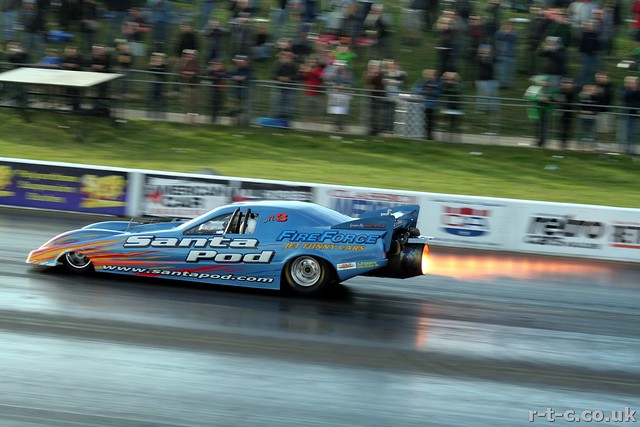
Jet dragster Fireforce 3 races to 266 mph by Tim R-T-C, on Flickr
#47

Posted 01 August 2012 - 18:42
RL
#48

Posted 01 August 2012 - 19:12
#49

Posted 01 August 2012 - 19:57
Geraint "Speed" Owen, university lecturer, VSCC racer and custodian of "Babs", built a 1928 Riley with a 6.1 litre Gypsy Moth engine:
A beautifully rendered device.
"Babs", of course, also being an aero-engined land speed record car.
This car has been in Vancouver for several years now owned by David Cohen.
In fact, the photo was taken in Vancouver.
Edited by David Birchall, 01 August 2012 - 19:58.
#50

Posted 02 August 2012 - 09:01

Uploaded with ImageShack.us

Uploaded with ImageShack.us
David Van Dal pics.






